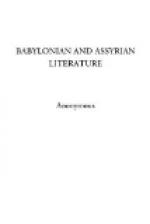goddess of the city, well-feasted, (rejoice with thee).
21 On that day from the curse may my heart, O my god and my goddess, be delivered, 22 and may the enchantment go forth from my body. 23 When the doom comes upon thee, 24 and from the fulfilment thou protectest thyself, 25 the doom when fulfilled cut thou off.
26 (The tablet) beginning: ...
Colophon.
Tablet (copied from)
the old (tablets of Chaldea).
Country of (Assur-bani-pal)
King of (Assyria).
[Footnote 1: Or, “rest.”]
[Footnote 2: The words translated “rejoicing” and “rejoice” properly signify “rest” and that may be their meaning here.]
INSCRIPTION OF TIGLATH PILESER I, KING OF ASSYRIA
TRANSLATED BY SIR H. RAWLINSON, K.C.B., D.C.L., ETC.
This inscription of Tiglath Pileser I is found on an octagonal prism and on some other clay fragments discovered at Kalah-Shergat and at present in the British Museum. The text is published in the “Cuneiform Inscriptions of Western Asia,” Vol. I, pp. ix-xvi. Four translations of this inscription, made simultaneously in 1857 by Sir H. Rawlinson, Mr. Fox Talbot, Dr. Hincks, and Dr. Oppert, were published in that year under the title of “Inscription of Tiglath Pileser I, King of Assyria, B.C. 1150.” Dr. Oppert has also given a revised translation in his “Histoire de l’Empire de Chaldee et d’Assyrie,” 8vo, Versailles, 1865, extracted from the “Annales de la Philosophie chretienne” of the same year, 5e Series, p. 44 and foll. The translations simultaneously published were submitted to the Asiatic Society in that year as a test of the advance made in Assyrian interpretations and the close approximation made by scholars in their interpretation of Assyrian texts. The notes contain some of the different readings of the other Assyrian scholars at that time and give a few of the principal varieties of reading some of the words. It was generally considered a very triumphant demonstration of the sound basis on which the then comparatively recent Assyrian researches were placed and a confutation of certain opinions then prevalent, that no certain or accurate advance had been made in the decipherment of Assyrian inscriptions. On the whole for its extent and historical information relating to the early history of Assyria this inscription is one of the most important of the series showing the gradual advance and rise of Assyria, while as one of the first interpreted it presents considerable literary interest in respect to the details of the progress of Assyrian interpretation. It is also nearly the oldest Assyrian text of any length which has been hitherto discovered and is very interesting from its account of the construction of the temples and palaces made by the King in the early part of his reign. S.B.




